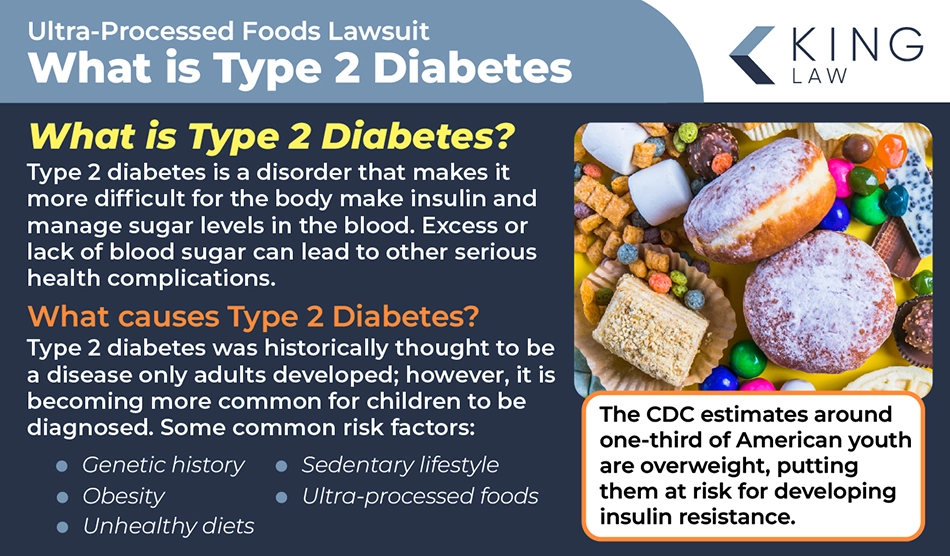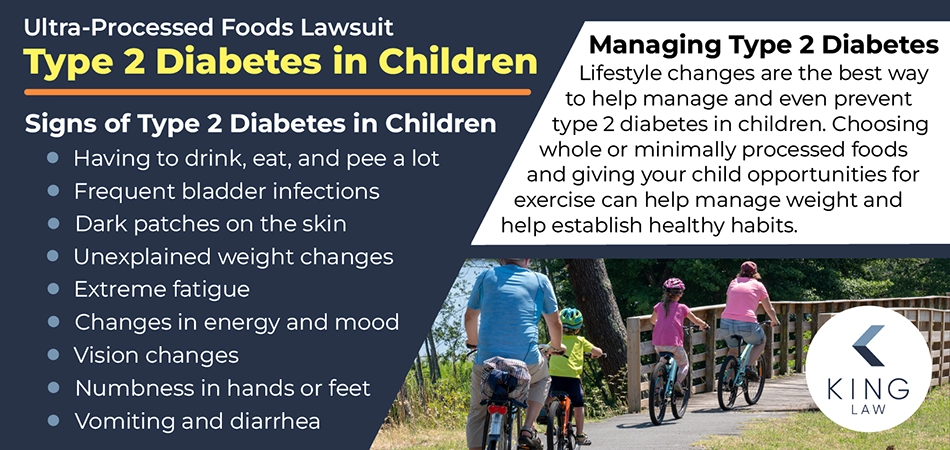
When children have type 2 diabetes, their bodies have a difficult time producing enough insulin to properly regulate blood sugar levels. Type 2 diabetes used to be considered something only adults got; however, more children are developing this disease in recent years. Evolving research has found children whose diets are high in ultra-processed foods have a higher risk of developing type-2 diabetes and other serious medical conditions.
In this article, we will discuss the causes and signs of type 2 diabetes in children, as well as management strategies for the disease. We will explore practical tips to help children stay healthy and limit their type 2 diabetes risk, including dietary modifications. Lastly, we touch on ongoing lawsuits parents and young adults are filing against food manufacturers for contributing to a rise in childhood type 2 diabetes.
About Type 2 Diabetes in Children:
About Type 2 Diabetes in Children
What Causes Type 2 Diabetes in Children?
Ultra-Processed Foods Linked to Childhood Type 2 Diabetes
Symptoms and Diagnosis of Type 2 Diabetes in Children
Complications of Type 2 Diabetes in Children
How to Prevent and Manage Type 2 Diabetes in Children
Lawsuits Against Ultra-Processed Food Manufacturers
About Type 2 Diabetes in Children
Type 2 diabetes is a disorder that makes it harder for the body to produce insulin and manage the amount of sugar in the bloodstream. Historically, type 2 diabetes was something that only adults developed; however, it is becoming more common for children to be diagnosed with this disease.
Risk factors for type 2 diabetes include having a family member with type 2 diabetes, being obese or overweight, sitting for long periods each day, not getting enough exercise, and having a large waist size. Many researchers and advocates blame the rise in ultra-processed food for the increase in childhood type 2 diabetes.
What Causes Type 2 Diabetes in Children?
Researchers think there are many factors that contribute to a child developing type 2 diabetes. While researchers are still learning about the exact causes and mechanisms of type 2 diabetes, they believe that genetics, an inactive lifestyle, an unhealthy diet, and obesity can drive its development. Type 2 diabetes can happen if the child’s body is not able to make and use insulin to regulate their blood sugar levels. Because of this insulin resistance, the child’s body has too much sugar in their blood, which can cause various adverse health conditions
Genetic and Family History
Researchers have noted that type 2 diabetes tends to run in families, which suggests that someone’s genes may play a role. For example, a 2013 study reported that someone has a 40 percent chance of developing type 2 diabetes if one of their parents has it and a 70 percent chance if both of their parents have the disease.
Additionally, children who are African American, Native American, Hispanic, and Asian are more likely to have type 2 diabetes than their non-Hispanic white peers. Medical professionals believe the reasons for this ethnic difference may include many factors, including genes, environmental exposures, and socioeconomic status.
Obesity and Insulin Resistance
Children who are obese have a high likelihood of developing type 2 diabetes because of how insulin resistance changes many critical bodily functions. For example, when the body has more fat than it should, especially on someone’s stomach, this can make the body insulin-resistant. Insulin is needed to help regulate how much sugar—glucose—is in the bloodstream.
Between 2017 and 2020, about 19.7 percent of children were obese, meaning their body mass index was in the 95th percentile. In contrast, the World Health Organization reports that, globally, just 2 percent of children aged 5 to 19 were obese, and 8 percent of children in that age range were overweight in 1990. The rise of type 2 diabetes among children has grown alongside the increase in obesity and being overweight in childhood.
Lack of Physical Activity
Children with an inactive lifestyle tend to have higher rates of obesity and type 2 diabetes. Physical activity helps your body use insulin effectively and helps it manage blood sugar levels.
The mass consumption of ultra-processed foods and sedentary lifestyles are relatively new experiences in childhood. Children from earlier generations often spent most of their time eating whole or minimally processed foods and playing outside. In modern times, many children eat high amounts of UPFs and spend hours watching television or playing video games.
Studies have shown that children who are obese and have type 2 diabetes are significantly more sedentary than their non-obese counterparts without type 2 diabetes. This suggests that physical activity is a protective factor against type 2 diabetes.
Unhealthy Diets and Ultra-Processed Foods
In addition to an inactive lifestyle, poor nutrition also appears to play a significant role in a child developing type 2 diabetes. In particular, researchers have discovered that consumption of ultra-processed foods can disrupt the body’s ability to make and use insulin, which can lead to type 2 diabetes in children.
Ultra-processed foods often include extracted or synthetic parts of foods—like sugars, oils, starches, protein isolates, and fats—that are combined to create hyper-palatable foods. Examples of UPFs are sugary cereals, sodas, cheese-flavored crackers, chips, candy, refined pretzels, and baking mixes. Because these foods are hyper-palatable, many children are becoming addicted to ultra-processed foods, which have negative effects on children’s physical and mental health.

Ultra-Processed Foods Linked to Childhood Type 2 Diabetes
Ultra-processed foods are processed foods made by combining ingredients extracted from other foods or created in a lab. Typically, these foods contain a large amount of sugars, additives, refined carbohydrates, and unhealthy fats. Many ultra-processed foods are considered junk foods. Researchers have discovered a concerning link between eating large amounts of UPFs each day and becoming obese or insulin resistant (which is a precursor to type 2 diabetes).
Many people blame UPF manufacturers for how they have made and marketed ultra-processed foods to the public and children. For example, many UPFs—like sugary cereals—have cartoon images on them that are appealing to children. Some people believe the labeling misleads consumers about the actual health benefits of these products and the risks of children becoming addicted to them. In turn, many think these food companies are fueling the startling rise in childhood obesity and type 2 diabetes.
Symptoms and Diagnosis of Type 2 Diabetes in Children
It can be challenging for parents and medical professionals to recognize the onset of type 2 diabetes in children because many children do not show any symptoms. Moreover, some of the first signs of childhood type 2 diabetes are the same as for other conditions, like the flu or hormonal changes associated with puberty.
Common Symptoms of Type 2 Diabetes in Children
Some children with type 2 diabetes do not have any symptoms at all. However, those who do may experience the following:
- Having to drink, eat, and pee a lot
- Getting bladder infections frequently
- Dark patches on the skin
- Unexplained weight gain or loss
- Extreme fatigue
- Notable fluctuations in energy and mood
Children with type 2 diabetes may also experience vision changes and lose feeling in their extremities (like their hands and feet). They may also vomit and have diarrhea more than usual, especially when they do not have the flu or other sickness.
How Doctors Diagnose Children with Type 2 Diabetes
Doctors diagnose a child with type 2 diabetes by performing blood tests to see what their blood sugar levels are. The doctor may ask your child to fast for some time (such as eight hours) before they get the blood test. This is so the doctors can see the child’s baseline levels without having outside factors—like the child’s breakfast—creating a false positive or negative result. Or, the doctor will do a randomized blood test, which may not require your child to fast beforehand.
Complications of Type 2 Diabetes in Children
Untreated childhood type 2 diabetes can have serious long-term complications. For example, children with type 2 diabetes may develop blindness, experience kidney failure, and suffer neurological damage and heart disease.
Medical research also shows that children with type 2 diabetes have a higher risk of needing dialysis or an amputation. As the children grow into adulthood, the fact that they have type 2 diabetes also increases their chances of being obese and having non-alcoholic fatty liver disease. UPFs are often seen as a potential driver of childhood type 2 diabetes, and the impacts can be profound and lifelong.
How to Prevent and Manage Type 2 Diabetes in Children
Parents can help manage and possibly reverse their children’s type 2 diabetes by making changes to things like their diet, activity level, and time spent outdoors. Instead of relying on quick and easy meals and snacks—like instant noodles, cereal, and crackers—fill your child’s plate with whole or minimally processed foods, which are different than ultra-processed foods. For example, give your child apples and bananas to snack on instead of potato chips or artificially flavored fruit gummy snacks.
You can also swap out video games and TV time for active alternatives like playing tag, going to the playground, swimming, and hiking. Eating right and being outdoors and active can help children’s bodies naturally learn (or re-learn) to use insulin properly. Children may also need to take medicine or injections to help them manage their blood sugar levels. Talk to your child’s doctor to develop an appropriate care plan to manage your child’s weight and type 2 diabetes.

Lawsuits Against Ultra-Processed Food Manufacturers
Many people believe large corporations develop highly addictive ultra-processed foods and market those foods to children knowingly, despite the risks. These actions have led many parents to file lawsuits against ultra-processed food manufacturers. These companies have spent billions of dollars advertising UPFs to consumers, with a particular focus on children. They have also invested substantial funds in food engineering to make these foods ultra-palatable and addictive. These tactics have resulted in many negative health impacts to children.
Young adults and parents with children who have type 2 diabetes are standing up against these practices by filing lawsuits in state and federal courts. Consumers believe children are becoming addicted to UPFs and that the food manufacturers knew of this risk and continued to market these foods to children anyway.
Our legal team is helping children and young adults who are affected by type 2 diabetes or non-alcoholic fatty liver disease because of a UPF consumption. We are helping consumers request compensation and demand accountability and much-needed change to protect the next generation from the harms of ultra-processed foods. Contact our team to understand how you can file an ultra-processed food lawsuit.
Contact King Law for a Free Case Evaluation
If you or your child developed childhood type 2 diabetes and consumed ultra-processed foods, get in touch with us today for a free case evaluation. You can reach us by calling (585) 316-0536 or filling out an online contact form. We will not charge you any upfront legal fees to take your case.

